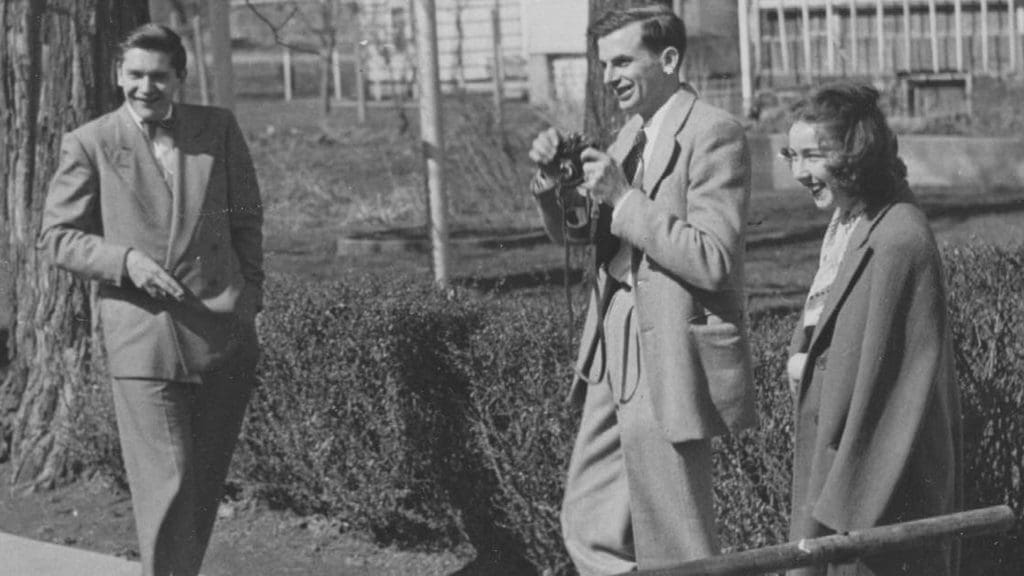I
In the summer of 2020, Loyola University in Maryland removed Flannery O’Connor’s name from a residential hall that had been named for her just thirteen years earlier. It happened one month after Paul Elie published his essay “How Racist Was Flannery O’Connor?” in The New Yorker. There was no opportunity for extended conversation, no effort to look at her work as a whole. Even a petition signed by Alice Walker was not enough to get Loyola to change its mind.
O’Connor was a master of irony, and the layered ironies here would not have been lost on her. Were she alive today, she might quip, “Let him who is without sin be the first to put his name on a building.” She knew she had areas of self-protective blindness, because exposing such blindness was the point of all her stories. The richest irony in efforts to dismiss O’Connor is that her fiction provides the insight we need right now to help heal our social and political divisions, and to temper our hostile public discourse. Because Flannery O’Connor, with her scorching wit, fingered the exact cause of all of it, including racism: fear.
Self-protective fear is a basic animal instinct. When threatened, most animals seek safety in the herd, and humans are no different. The neuropsychologist Joshua Greene argues that our brains are wired for tribalism. “We intuitively divide the world into Us and Them, and favor Us over Them,” he writes. In humans this intuition comes at a high cost to our goals. It thwarts our efforts at social cooperation and prevents us from truly listening to those who are different from us. It leads us to demonize Them to keep our own self-righteous place secure. It makes us think that changing our minds about something is an act of weakness instead of a sign of healthy humility.
Thus I’m convinced that O’Connor’s “The Displaced Person,” a story about the violence of self-protective blindness, is a story for our age. It should be read and discussed in classes as well as book groups, church groups, and—dare I suggest it?—Trump-divided extended families like my own.
I don’t say this flippantly. I have devoted my career to explaining why we must think through fiction and allow ourselves to be opened and examined by it. Good fiction isn’t an argument; it’s an invitation to accurate and redemptive self-knowledge. “The Displaced Person” invites us to consider how we fearfully create illusory selves bolstered by our tribal affiliations. The story insists that our own unwillingness to admit that we could be wrong is a spiritual problem that requires a spiritual solution. It ultimately asks us to be displaced from our fearful tribalism by the most powerful force of all: love.
Good fiction isn’t an argument; it’s an invitation to accurate and redemptive self-knowledge.
“The Displaced Person” is set on a farm like Andalusia, the farm in central Georgia where O’Connor lived with her mother and the motley collection of peafowl she adored. The farm is postwar American tribalism in microcosm. There’s the owner, Mrs. McIntyre, who fancies herself to be above the hired help: Mr. and Mrs. Shortley. The Shortleys, in turn, fancy themselves to be above the black workers on the farm. Things move along relatively peacefully until something comes in to upset the fruit basket. That something is the displaced person, Mr. Guizac, newly arrived from World War II Poland with his family. Since his arrival threatens Mrs. Shortley’s place in particular, O’Connor opens her story with the character’s effort to re-assert her importance:
It’s a brilliant opening. Mrs. Shortley, with her fiercely ironic name, has ascended a self-made molehill to become the monarch of all she surveys. Her “grand self-confidence” comes from her position on the farm, made secure only by ignoring the “white afternoon sun,” which appears to her like an intruder. And it is indeed an intruder, because in O’Connor’s stories, the sun always stands for reality—the revealing light that shines into the darkness—which we ignore to our peril. We quickly find out that Mrs. Shortley has already decided to think of the Guizacs, whom she calls the “Gobblehooks,” as a threat. “The trouble with these people was, you couldn’t tell what they knew. Every time Mr. Guizac smiled, Europe stretched out in Mrs. Shortley’s imagination, mysterious and evil, the devil’s experiment station.” When Mr. Guizac proves to work much harder and more efficiently than Mr. Shortley, Mrs. McIntyre declares, “That man will be my salvation!” Mrs. Shortley, her position on the farm threatened, entrenches herself in her tribal views. “With foreigners on the place, with people who were all eyes and no understanding, who had come from a place continually fighting, where the religion had not been reformed—with this kind of people, you had to be on the lookout every minute. She thought there ought to be a law against them. There was no reason they couldn’t stay over there and take the places of some of the people who had been killed in their wars and butcherings.”
Self-protective fear necessarily seeks tribal affirmation. Those people come from a violent place; we are peaceful. They come from a backward place; we are civilized. It is tribalism that leads Mrs. Shortley to shut her eyes to the beauty of other persons (which O’Connor often signified by peacocks) and to “prophesy” about the evil spreading here from “unreformed” Europe. After trying to get the black hired hands to agree with her about the displaced person’s threat to them all, “she stood a while longer, reflecting, her unseeing eyes directly in front of the peacock’s tail. He had jumped into the tree and his tail hung in front of her, full of fierce planets with eyes that were each ringed and green. . . . She might have been looking at a map of the universe but she didn’t notice it any more than she did the spots of sky that cracked the dull green of the tree. She was having an inner vision instead.” The problem is that Mrs. Shortley’s eyes are unseeing. She misses the beauty right in front of her by favouring her inner vision, which features herself as a truth-telling prophet. Eyes shut, she sees “the ten million billion of them pushing their way into new places over here and herself, a giant angel with wings as wide as a house, telling the Negroes that they would have to find another place.”
No one can miss the self-appointed “giant angels” of our own time, from the protectors of the country against “hordes” of immigrants to the administrators who deny anyone with undesirable views a university speaking engagement. But O’Connor’s story, published in 1955, helps us see how and why American tribalism has a distinctly evangelical flavour and imprimatur. The text that first helped me see how deeply and destructively that is the case is Sacvan Bercovitch’s The Puritan Origins of the American Self, written in 1975, and reprinted with a new preface in 2011. Long before the rise of Donald Trump or even of Ronald Reagan, Bercovitch definitively traced the origins and perpetuation of a “religio-modernist rhetoric” that attempted to establish America as a city on a hill, the new Jerusalem. The early Puritans, “with an arrogance that astounded their contemporaries, Protestant no less than others, . . . identified America as the new promised land, foretold in scripture, as preparatory to the Second Coming.” The Puritan migration was styled as an escape from the Babylon of unreformed Europe.
This religiously motivated tribalism has sunk deeply into American culture. One of its most pernicious consequences has been to sanctify the ideology of the American way as religion. No one who has read Bercovitch’s book can be surprised by anything that has happened in America since 2016. We can only be chagrined at the speed with which some faith congregations have moved to a near total identification of Christian faith with Republican Party ideology as defined by Donald Trump. This is naked tribalism, complete with signalling and shibboleths. It has happened so quickly and forcefully that most of us are still reeling, left with fewer and fewer ways to help people—even in our own families—see how destructive this kind of thinking can be. I’m frequently moved by David French’s efforts to uncover it. “What if white Evangelicals are disproportionately flocking to outlier political positions because of a combination of factors that have little to do with theology at all? Instead, what if they’re shaped by far more mundane (though still quite powerful) cultural forces that ultimately have little to do with faith and then misinterpreting the cultural as theological?” If that’s the case, he points out, both the church and the nation are in trouble. Because with all of this comes the saddest irony of all: faith in America is now the biggest barrier to genuine Christian faith among Americans. The irony is severe, for genuine Christian faith is the kind of faith that can motivate loving connection between diverse groups of people. The kind of faith that can lead us to admit we were wrong. The kind of faith that can change things. French puts a fine point on it: “It’s one thing to discuss an issue with someone who understands their position is debatable. It’s another thing entirely to engage with a person or community who equates compromise with apostasy.” And here we are.
Can this recent exposure of religio-political ideology as rank tribalism be a good thing? I think so, but only if we truly recognize it.
Can this recent exposure of religio-political ideology as rank tribalism be a good thing? I think so, but only if we truly recognize it. We must shine a strong light into the real motivations behind it all. It takes at least two tribes, each motivated by self-protective fear and self-righteous certainty, for tribalism to wreak its violence. Lest readers think that only middle-class religious folk demonize others, O’Connor gives us Mrs. McIntyre, the farm owner. Although she prides herself in having hired workers (like the Shortleys) who are “not quite trash,” she could easily have called them all a “basket of deplorables.” While initially she enjoys Mr. Guizac’s hard work—and eventually fires the Shortleys—she soon sees the writing on her own wall. She, too, will be displaced from her position. Mr. Guizac works harder and more efficiently than she does, and he has no respect for the hierarchy. When she learns that Mr. Guizac is hoping to marry one of the black workers to a cousin of his to help her escape her oppressive living situation, she calls him a monster. She begins to feel she had been “tricked by the priest” who brought the Guizacs to them. Fear causes her to retreat into her own version of Us and Them. “‘They’re all the same,’ she muttered, whether they come from Poland or Tennessee. . . . All her life she had been fighting the world’s overflow and now she had it in the form of a Pole. ‘You’re just like all the rest of them,’ she said, ‘—only smart and thrifty and energetic but so am I. And this is my place.’” She decides to get rid of him and rehire the safer Shortleys.
Mrs. McIntyre is trying to bring herself to fire him when another solution to “the world’s overflow” presents itself. When Mr. Guizac is working under the small tractor, the brake on the nearby large tractor slips, and it rolls down an incline toward him, unaware. Mrs. McIntyre hears it slip, sees it moving slowly toward him, and starts to shout—but then does not. “She had felt her eyes and Mr. Shortley’s eyes and the Negro’s eyes come together in one look that froze them in collusion forever, and she heard the little noise that the Pole made as the tractor wheel broke his backbone.” If there is a more striking picture of how tribalism works, I do not know what it is. Self-protective fear, especially when coupled with certainty of one’s own righteousness, can only end in violence—even death. And doing nothing to help can be the most insidious act of violence of all.
That we all do things like this, but are also too proud to admit it, is why tribalism is such a hard nut to crack. Joshua Greene insists that the only way to effect social cooperation is to embrace utilitarianism. But to repeat, O’Connor understood that self-protective fear is a spiritual problem requiring a spiritual solution. The priest who brought the displaced family to the farm recognizes that opportunities for genuine spiritual growth come by challenges, but also that the growth can only come into a softened and humble heart. When he has tried to convince Mrs. McIntyre not to fire Mr. Guizac, his eyes wander to the peacocks on the lawn, where one is opening its tail. “Tiers of small pregnant suns floated in a green gold haze over his head. The priest stood transfixed, his jaw slack. Mrs. McIntyre wondered where she had ever seen such an idiotic old man. ‘Christ will come like that!’ he said in a loud gay voice and wiped his hand over his mouth and stood there, gaping.” Mrs. McIntyre, like Mrs. Shortley, closes her eyes to the beauty of all of humanity. She refuses the call to love her neighbour as herself. Instead, she hunkers down in place. Her “face assumed a set puritanical expression and she reddened. Christ in the conversation embarrassed her the way sex had her mother. ‘It is not my responsibility that Mr. Guizac has nowhere to go,’ she said. ‘I don’t find myself responsible for all the extra people in the world.’” It is after this refusal that she lets the tractor roll over Mr. Guizac’s back, providing the story’s gruesome final solution.
O’Connor’s stories almost always end with the opportunity for the character to grow (often a very brief opportunity!) rather than the growth itself. A character’s complete conversion into someone able to take loving responsibility for her actions is a much harder story to tell, and O’Connor believed that even a trace of sentimentality only lets readers off the hook. But there is always someone in the stories who serves as a true prophet, speaking the truth and thereby enacting tough love. In this story that prophet is the priest. After her failure to warn Mr. Guizac, Mrs. McIntyre develops a “nervous affliction” and must give up running the farm. She has no friends or family. Only this priest comes to visit her once a week, sitting by her bed and gently explaining the doctrines of the church. We can imagine him emphasizing Christ’s love as both a displacing and a replacing love, as the only perfect love. The only love with the power to cast out fear. How Mrs. McIntyre will respond we can only guess.
“The Displaced Person” ultimately reveals why O’Connor believed that moments of grace must be violent—they must pierce staunchly resistant illusions—but also why these moments are gifts. Despite O’Connor’s reputation for violence toward her characters, this story, like all her stories, is itself a gentle gift for readers. It invites us to redemptive self-knowledge. It reminds us that no one deserves their name on a building. It reminds us to consider the others we think ourselves superior to, but whom we actually fear. It invites us to consider our own failures of love: what we have done, and what we have left undone. What we do with that moment of self-recognition has always been up to us.







